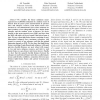121
click to vote
CISS
2008
IEEE
15 years 7 months ago
2008
IEEE
—We present a distributed algorithm for allocating power among multiple interfering transmitters in a wireless network using Orthogonal Frequency Division Multiplexing (OFDM). Th...
130
Voted
CISS
2008
IEEE
15 years 7 months ago
2008
IEEE
—Thus far, sparse representations have been exploited largely in the context of robustly estimating functions in a noisy environment from a few measurements. In this context, the...
106
click to vote
CISS
2008
IEEE
15 years 7 months ago
2008
IEEE
Abstract— This paper presents an analysis of target localization accuracy, attainable by the use of MIMO (MultipleInput Multiple-Output) radar systems, configured with multiple ...
102
click to vote
CISS
2008
IEEE
15 years 7 months ago
2008
IEEE
Abstract— We consider the linear minimum meansquared error (LMMSE) estimation of a random vector of interest from its fusion frame measurements in presence noise and subspace era...
112
Voted
CISS
2008
IEEE
15 years 7 months ago
2008
IEEE
—This paper studies the design and analysis of optimal training-based beamforming in uncorrelated multipleinput multiple-output (MIMO) channels with known Gaussian statistics. Fi...
126
Voted
CISS
2008
IEEE
15 years 7 months ago
2008
IEEE
—In this paper, we propose a low complexity linear multiuser beamforming system for the multiple-input multipleoutput (MIMO) broadcast channel. We consider the specific case of ...
140
click to vote
CISS
2008
IEEE
15 years 7 months ago
2008
IEEE
—We propose a new scheme for limited feedback in MIMO systems. We consider transmit beamforming and receiver maximal ratio combining as a base for our work, and propose a novel b...
CISS
2008
IEEE
15 years 7 months ago
2008
IEEE
85
Voted
CISS
2008
IEEE
15 years 7 months ago
2008
IEEE
—The results of 2 experiments in Costas arrays are presented, for which theoretical explanation is still not available: the number of dots on the main diagonal of exponential Wel...
118
click to vote
CISS
2008
IEEE
15 years 7 months ago
2008
IEEE
—Large-scale wireless networks must be designed such that there are no gaps in coverage. It is also desirable to minimize the number of access points used in order to minimize th...







